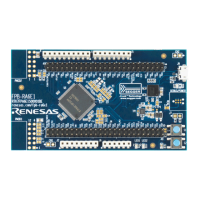Renesas RA Family RA4 Quick Design Guide
R01AN5988EU0100 Rev.1.00 Page 5 of 51
Jul.21.21
Chapter 5, “Resets”, discusses the Power-On Reset and how to differentiate this from other reset sources.
Chapter 7, “Low Voltage Detection”, provides details on the Low-Voltage Detection Circuit that can be used
to monitor the power supply. Chapter 6, “Option-Setting Memory”, additionally describes how to enable Low-
Voltage Detection 0 Circuit automatically at startup.
Chapter 11, “Battery Backup Function”, shows how to provide battery backup to the RTC and sub-clock
oscillator.
If you plan to use the on-chip Analog to Digital Converters (ADC) or the Digital to Analog Converter (DAC),
see 12-Bit A/D Converter (ADC12) or 14-Bit A/D Converter (ADC14) and 12-Bit D/A Converter (DAC12) for
details on how to provide filtered power supplies for these peripherals.
Table 3. RA4 MCU Groups, User’s Manual: Hardware
Lists power pins in each package with notes on termination and bypassing.
Discusses the Power-on Reset and how to differentiate this from other
reset sources.
Voltage Detection Circuit
Provides details on the Low-Voltage Detection Circuit that can be used to
monitor the power supply.
Using low power modes may allow you to reduce the voltage of the power
supply. See this chapter for details on how operating modes affect power
supply requirements.
Shows how to provide battery backup to the RTC and sub-clock oscillator
14-Bit A/D Converter
12-bit D/A Converter
If you plan to use the on-chip A/D or D/A converters, these chapters give
details on how to provide filtered power supplies for these peripherals.
Provides detailed descriptions on how to configure and use the available
clocks, including PCB design recommendations.
2. Emulator Support
RA MCU devices have an emulator interface that supports both debugging using SWD or JTAG
communication, and serial programming using SCI communication. This emulator makes it easy to switch
between debugging and serial programming.
The SWD or JTAG emulator interface should be connected to an Arm
®
-standard 10-pin or 20-pin socket.
MD, TXD, and RXD pins are added for serial programming using SCI communication.
The serial programming interface must be used to program the Arm
®
TrustZone
®
IDAU boundary register
settings. For devices that support TrustZone, it is recommended to connect P300/SWCLK/TCK and
P201/MD pins using a wired-OR circuit on the board to use both debugging and serial programming.
Emulator support is useful for product development and prototyping, but may not be needed once a design
moves to production. If emulator support is no longer needed for a design, make sure to configure the ports
according to the “Handling of Unused Pins” section of the related MCU Hardware User’s Manual. See also
section 10.5 in this document.

